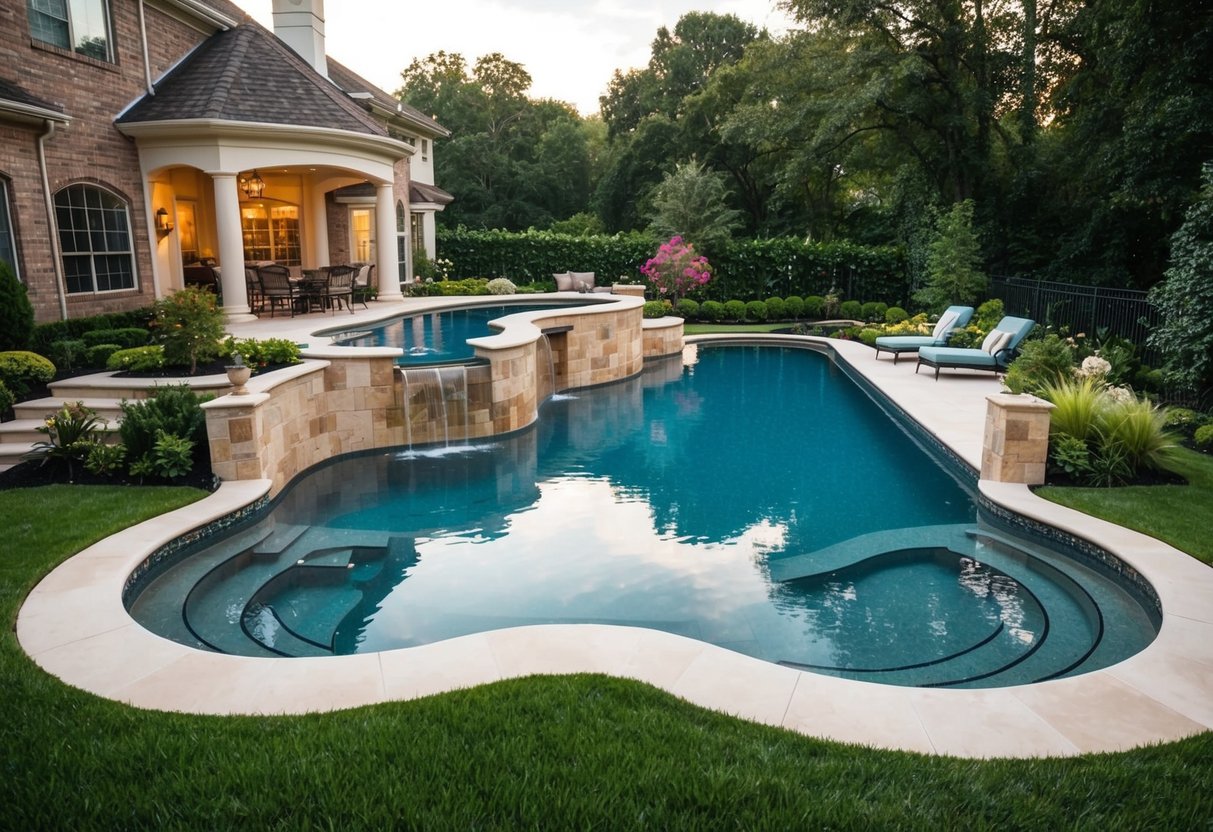Understanding Custom Pool Design
When it comes to designing a custom pool, it’s crucial to consider the pool’s purpose and features, choose an appropriate shape and size, and select the perfect location. These factors will help ensure that the pool meets our needs and enhances our outdoor space.
Determining Pool Purpose and Features
First, we need to clarify why we want a pool. Are we focusing on relaxation, exercise, or entertainment? This will guide our choices.
We might add features like waterfalls, fountains, or a tanning ledge. If swimming laps is our goal, a long and straight design suits us well.
For fun elements, we could include diving boards or various steps for ease of access. These decisions shape how we enjoy our custom pool.
Choosing the Right Pool Shape and Size
Selecting the right shape and size is vital. Rectangular pools are great for formal settings, while kidney-shaped designs offer a more natural appearance.
We should think about how much space we have and how a specific shape will fit into our yard. The size should accommodate our intended use, whether it’s for family fun or rigorous workouts.
A larger pool might suit our needs if hosting large gatherings is a priority.
Selecting the Ideal Location
Location is key in maximizing our pool’s value and enjoyment. We want a spot that provides ample sunlight but also allows for some shade. Placing the pool close to the house can integrate the pool into our lifestyle.
We should think about privacy and views. Also, evaluating the landscaping and soil conditions will help us avoid future issues such as drainage problems.
Our selected location should enhance the pool and complement our home’s outdoor aesthetics.
Planning for Pool Construction

When planning to construct a pool, several important considerations come into play. We must focus on aligning the design with our budget, understanding regulations, and selecting the right materials and aesthetics.
Aligning Pool Design with Budget
Budget plays a crucial role in pool design. We should begin by setting a realistic budget that includes construction, maintenance, and any unexpected costs. In-ground pools tend to be more expensive than above-ground pools. Choosing between fiberglass, plaster, and tile also impacts costs.
We must prioritize what features are essential and what can be modified or eliminated to save money. A clear budget helps in making decisions about size, shape, and additional features like lighting or heating.
Navigating Zoning and Regulations
Understanding local zoning laws and regulations is essential. We need to check with local authorities to ensure our plans meet all requirements. This can include permits, inspections, and specific spatial guidelines.
Some areas may have restrictions on pool depth or location. Knowing these rules helps avoid future legal issues and potential fines. Collaborating with a professional who knows local codes can simplify this process.
Selecting Pool Materials and Aesthetics
Choosing the right pool materials affects not just the look but also the lifespan and maintenance of our pool. Fiberglass materials offer durability but have limited design options.
Plaster provides a classic look, while tile offers variety in color and design. We should consider how these materials will complement the surrounding landscape and match our aesthetic preferences.
Materials also affect maintenance. For instance, tiles might need routine cleaning, and plaster may require resurfacing. Taking these factors into account helps align our choices with our long-term vision for the pool.
Enhancing Poolside Experience

Enhancing the poolside experience involves thoughtful integration of landscaping and outdoor living areas, along with prioritizing safety and accessibility. This ensures that our pool area is not only beautiful but also functional and safe for everyone.
Integrating Landscaping and Outdoor Living Spaces
Effective landscaping can transform our backyard pool into a private oasis. We should consider adding greenery, such as trees and shrubs, to provide shade and privacy. Using native plants can also simplify maintenance and support local ecosystems.
Outdoor living spaces, like a pavilion or a deck, can extend our living area and create a perfect spot for relaxation. An outdoor kitchen adds convenience and makes entertaining poolside effortless. Incorporating seating options, such as lounge chairs or a dining set, enhances comfort and usability for family gatherings and parties.
Collaborating with a custom pool builder or pool designer can help us create a seamless flow between the pool and the rest of our yard. Their expertise ensures that the design complements our home’s architecture and meets our preferences.
Ensuring Safety and Accessibility
Safety is paramount when installing a swimming pool. It is essential to incorporate safety features like pool fences, which are designed to prevent unsupervised access. Alarms and pool covers further enhance safety, especially if we have young children or pets.
Accessibility is also crucial. Providing steps or a gentle slope into the pool can help people with mobility challenges. Non-slip surfaces around the pool minimize the risk of slipping and injuries.
We must consider the pool’s lighting. Proper illumination enhances visibility at night, reducing accidents. Consulting with professionals ensures that safety measures are correctly installed and meet all regulations, making our pool area a safe and enjoyable space for everyone.

